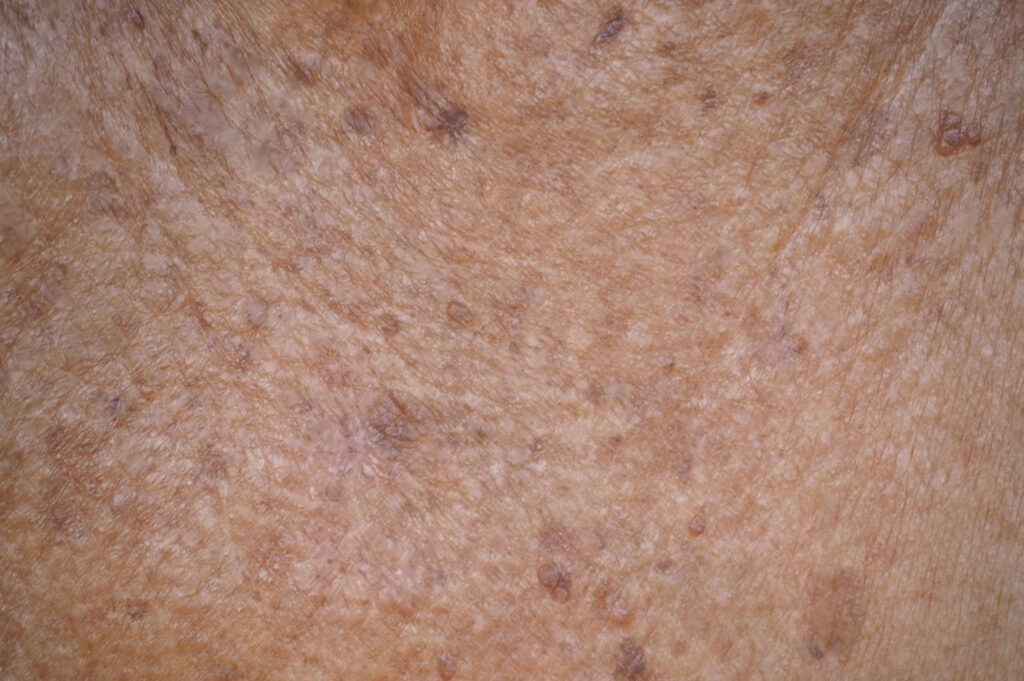Actinic Keratosis

What To Know About Actinic Keratosis
The name may be unfamiliar, but the appearance of actinic keratosis is common. Anyone who spends time in the sun runs a high risk of developing one or more.
An actinic keratosis, also known as a solar keratosis, is a scaly or crusty bump that arises on the skin’s surface. The base may be light or dark, tan, pink, red, or a combination of these or the same color as your skin. The scale or crust is dry and rough. Occasionally, it itches or produces a pricking or tender sensation. The skin lesion develops slowly and usually reaches a size from an eighth to a quarter of an inch.
A keratosis is most likely to appear on the face, ears, bald scalp, neck, backs of hands and forearms, and lips. It tends to lie flat against the skin of the head and neck and is elevated on the arms and hands.
Actinic Keratosis Is Dangerous
Actinic Keratosis can be the first step in the development of skin cancer. Therefore, it is referred to as a precursor of cancer or a precancer. It is estimated that up to 10 percent of active lesions, which are redder and more tender than the rest, will take the next step and progress to squamous cell carcinomas. They are usually not life-threatening, provided they are detected and treated in the early stages. However, left untreated, they can grow large and invade the surrounding tissue. On rare occasions, they metastasize or spread to the internal organs.
The most aggressive form of keratosis, actinic cheilitis, appears on the lips and can evolve into squamous cell carcinoma. When this happens, roughly one-fifth of these carcinomas metastasize. The presence of actinic keratoses indicates that sun damage has occurred and that any kind of skin cancer—not just squamous cell carcinoma—can develop.
What Does Actinic Keratosis Look Like?
The look of actinic keratosis varies depending on where it’s found on the body:
- Back of hand—scattered, thickened red, scaly patches.
- Sun-damaged forehead or bald scalp—small red bumps and/or small tan crusts.
- Lower lip—fissures filled with dried blood and large keratosis covered with thorny scale.
- Cheek and ear-crusted lesions—ranging in color from red to brown.
If you spot any of these, consult your doctor promptly.
Causes Of Actinic Keratosis
Sun exposure is the cause of almost all actinic keratoses. Sun damage to the skin accumulates over time so that even a brief exposure adds to the lifetime total. The likelihood of developing keratoses is highest in regions close to the equator. However, regardless of climate, everyone is exposed to the sun. Ultraviolet rays reflect off sand, snow, and other surfaces; about 80 percent can pass through clouds.
Are You at Risk?
People who have fair skin, blonde or red hair, and blue, green, or gray eyes are at the greatest risk. Because their skin has less protective pigment, they are the most susceptible to sunburn. Even those who are darker skinned can develop keratoses if they expose themselves to the sun without protection. African Americans, however, rarely have these lesions.
Individuals who are immunosuppressed as a result of cancer, chemotherapy, AIDS, or organ transplantation, are also at higher risk.
How Is It Treated?
There are several effective treatments for actinic keratosis. The right treatment for you will depend on the size, site, and aggressiveness of the lesion, as well as the health and wishes of the patient. Your dermatologist can help you choose among the following possible treatments:
- Cryosurgery– This is the most commonly used procedure. It involves freezing off the lesions through the application of liquid nitrogen with a special spray device or cotton-tipped applicator. It does not require anesthesia and produces no bleeding. There is a slight risk of scarring and hypopigmentation.
- Topical Medications – Multiple topical medications can be used at home to treat these lesions, especially when the lesions are large or numerous. Those medications include fluorouracil®, imiquimod®, Picato®, Soloraze®.
- Shave removal, curettage and electrodessication, or surgical removal
- Photodynamic therapy
Actinic keratosis is a warning signal for skin cancer. Heed that signal. If you believe you may have actinic keratosis anywhere on your face, body, or scalp, make an appointment with your dermatologist today.
Service Available at the Following Locations
Healthy Skin Starts With Us
